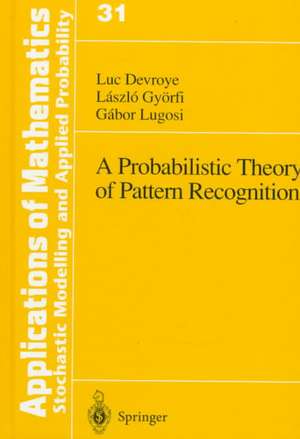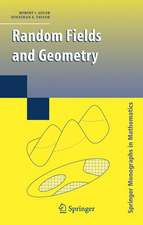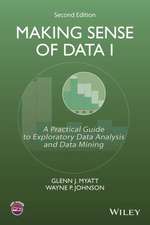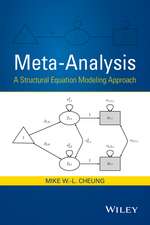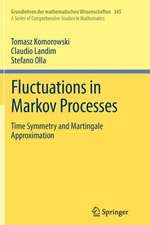A Probabilistic Theory of Pattern Recognition: Stochastic Modelling and Applied Probability, cartea 31
Autor Luc Devroye, Laszlo Györfi, Gabor Lugosien Limba Engleză Hardback – 4 apr 1996
| Toate formatele și edițiile | Preț | Express |
|---|---|---|
| Paperback (1) | 601.77 lei 6-8 săpt. | |
| Springer – 22 noi 2013 | 601.77 lei 6-8 săpt. | |
| Hardback (1) | 804.96 lei 6-8 săpt. | |
| Springer – 4 apr 1996 | 804.96 lei 6-8 săpt. |
Din seria Stochastic Modelling and Applied Probability
- 17%
 Preț: 464.60 lei
Preț: 464.60 lei - 18%
 Preț: 805.44 lei
Preț: 805.44 lei - 18%
 Preț: 1110.72 lei
Preț: 1110.72 lei - 18%
 Preț: 947.35 lei
Preț: 947.35 lei -
 Preț: 390.84 lei
Preț: 390.84 lei - 18%
 Preț: 952.40 lei
Preț: 952.40 lei - 15%
 Preț: 648.56 lei
Preț: 648.56 lei - 18%
 Preț: 951.91 lei
Preț: 951.91 lei - 15%
 Preț: 637.13 lei
Preț: 637.13 lei - 18%
 Preț: 793.63 lei
Preț: 793.63 lei -
 Preț: 391.02 lei
Preț: 391.02 lei -
 Preț: 401.42 lei
Preț: 401.42 lei - 15%
 Preț: 639.08 lei
Preț: 639.08 lei - 18%
 Preț: 733.33 lei
Preț: 733.33 lei - 18%
 Preț: 785.11 lei
Preț: 785.11 lei - 15%
 Preț: 593.42 lei
Preț: 593.42 lei - 18%
 Preț: 1114.96 lei
Preț: 1114.96 lei - 15%
 Preț: 643.16 lei
Preț: 643.16 lei -
 Preț: 390.63 lei
Preț: 390.63 lei - 15%
 Preț: 645.60 lei
Preț: 645.60 lei - 15%
 Preț: 641.71 lei
Preț: 641.71 lei - 18%
 Preț: 954.62 lei
Preț: 954.62 lei - 15%
 Preț: 645.14 lei
Preț: 645.14 lei - 18%
 Preț: 947.50 lei
Preț: 947.50 lei - 15%
 Preț: 644.63 lei
Preț: 644.63 lei - 20%
 Preț: 469.59 lei
Preț: 469.59 lei - 20%
 Preț: 581.39 lei
Preț: 581.39 lei
Preț: 804.96 lei
Preț vechi: 981.67 lei
-18% Nou
Puncte Express: 1207
Preț estimativ în valută:
154.02€ • 161.25$ • 127.45£
154.02€ • 161.25$ • 127.45£
Carte tipărită la comandă
Livrare economică 07-21 aprilie
Preluare comenzi: 021 569.72.76
Specificații
ISBN-13: 9780387946184
ISBN-10: 0387946187
Pagini: 638
Ilustrații: XV, 638 p.
Dimensiuni: 155 x 235 x 41 mm
Greutate: 1.1 kg
Ediția:1996
Editura: Springer
Colecția Springer
Seria Stochastic Modelling and Applied Probability
Locul publicării:New York, NY, United States
ISBN-10: 0387946187
Pagini: 638
Ilustrații: XV, 638 p.
Dimensiuni: 155 x 235 x 41 mm
Greutate: 1.1 kg
Ediția:1996
Editura: Springer
Colecția Springer
Seria Stochastic Modelling and Applied Probability
Locul publicării:New York, NY, United States
Public țintă
ResearchCuprins
Preface * Introduction * The Bayes Error * Inequalities and alternate
distance measures * Linear discrimination * Nearest neighbor rules *
Consistency * Slow rates of convergence Error estimation * The regular
histogram rule * Kernel rules Consistency of the k-nearest neighbor
rule * Vapnik-Chervonenkis theory * Combinatorial aspects of Vapnik-
Chervonenkis theory * Lower bounds for empirical classifier selection
* The maximum likelihood principle * Parametric classification *
Generalized linear discrimination * Complexity regularization *
Condensed and edited nearest neighbor rules * Tree classifiers * Data-
dependent partitioning * Splitting the data * The resubstitution
estimate * Deleted estimates of the error probability * Automatic
kernel rules * Automatic nearest neighbor rules * Hypercubes and
discrete spaces * Epsilon entropy and totally bounded sets * Uniform
laws of large numbers * Neural networks * Other error estimates *
Feature extraction * Appendix * Notation * References * Index
distance measures * Linear discrimination * Nearest neighbor rules *
Consistency * Slow rates of convergence Error estimation * The regular
histogram rule * Kernel rules Consistency of the k-nearest neighbor
rule * Vapnik-Chervonenkis theory * Combinatorial aspects of Vapnik-
Chervonenkis theory * Lower bounds for empirical classifier selection
* The maximum likelihood principle * Parametric classification *
Generalized linear discrimination * Complexity regularization *
Condensed and edited nearest neighbor rules * Tree classifiers * Data-
dependent partitioning * Splitting the data * The resubstitution
estimate * Deleted estimates of the error probability * Automatic
kernel rules * Automatic nearest neighbor rules * Hypercubes and
discrete spaces * Epsilon entropy and totally bounded sets * Uniform
laws of large numbers * Neural networks * Other error estimates *
Feature extraction * Appendix * Notation * References * Index
